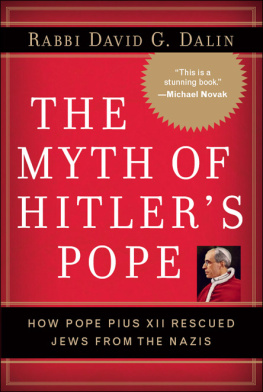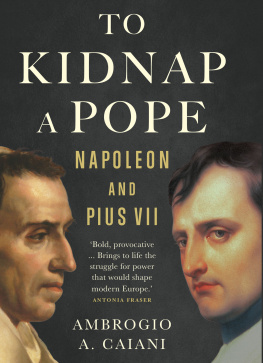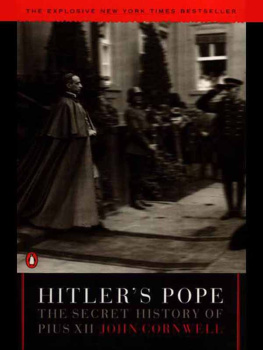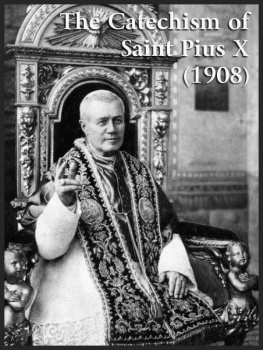Praise for Church of Spies
[Church of Spies] compellingly explores the papacys involvement in espionage during World War II.... Not only a dramatic disclosure of the Vaticans covert actions, but also an absorbing, polished story for all readers of World War II history.
Kirkus
While the Pope hesitated to publicly provoke Hitler in a foolhardy way, he had no hesitation in secretly opposing the Third Reich and its crimes. The record of the assistance Pius XII provided, through his representatives, to the German resistance, and the actions they took, under his guidance, is extraordinary. Without minimizing the complicity of individual Christians, or the role of Christian anti-Semitism, Mark Riebling shows that the Vatican took a very powerful stance against the Nazis. It is especially important for Jewish peopleand I am Jewish myselfthat this information is now being gathered for all to see.
SIR MARTIN GILBERT, official biographer of Winston Churchill
Church of Spies is an incredible book. It is authentic, documented history that reads like a great action novel. Protestant Pastor Dietrich Bonhoeffer, German Army Colonel Claus Schenk von Stauffenberg, the pope, and others plotted to kill Hitler and end the war. Riebling takes us inside their meetings (sometimes held among excavations under Vatican City) and meetings of Hitler and his top advisors. The story that emerges is at times terrifying, tragic, and yet ultimately heroic. This is a book not to be missed.
PROFESSOR RONALD J. RYCHLAK, author of Hitler, the War, and the Pope
Mark Riebling has set himself a high bar in turning conventional wisdom on its head. He has taken on one of the most controversial and polarizing issues in the history of World War II: the role of the wartime Vatican in fighting the Nazis. By combining new archival material with a lively and convincing narrative he has created a new account of a secret war previously overlooked. This is a highly original contribution to intelligence history.
COL. ROSE MARY SHELDON, Burgwyn Chair in Military History, Virginia Military Institute
Church of Spies captured my attention. It is a remarkable piece of research. It fills out much of the story that was known mainly in skeletal form. It makes the past come alive.
PROFESSOR VINCENT A. LAPOMARDA, author of The Jesuits and the Third Reich

Copyright 2015 by Mark Riebling Published by Basic Books, A Member of the Perseus Books Group All rights reserved. Printed in the United States of America. No part of this book may be reproduced in any manner whatsoever without written permission except in the case of brief quotations embodied in critical articles and reviews. For information, contact Basic Books, 250 West 57th Street, New York, NY 10107.
Books published by Basic Books are available at special discounts for bulk purchases in the United States by corporations, institutions, and other organizations. For more information, please contact the Special Markets Department at the Perseus Books Group, 2300 Chestnut Street, Suite 200, Philadelphia, PA 19103, or call (800) 8104145, ext. 5000, or e-mail .
Designed by Linda Mark
Library of Congress Cataloging-in-Publication Data Riebling, Mark.
Church of spies: the Popes secret war against Hitler / Mark Riebling.
pages cm Includes bibliographical references and index.
ISBN 978-0-465-06155-6 (e-book) 1. Pius XII, Pope, 1876-1958. 2. Catholic ChurchForeign relationsGermany. 3. GermanyForeign relationsCatholic Church. 4. World War, 19391945Vatican City. 5. World War, 19391945Religious aspectsCatholic Church. 6. Anti-Nazi movementVatican City. I. Title.
BX1378.R54 2015
282.09'044--dc23
2015024814
10 9 8 7 6 5 4 3 2 1
For Robin
How do we represent our religion?
Just as a system, or as glowing fire?
GERMAN JESUIT FATHER ALFRED DELP
CONTENTS
Guide
I N APRIL 1945, THE NAZIS TRIED TO BREAK THE MAN THEY CALLED the best agent of the Vatican Intelligence in Germany. On the surface, Josef Mller seemed just a big-eared Bavarian book publisher, who puffed a pipe and collected stamps. Yet since his arrest for giving Jews false papers and money, he had come to figure in a case of sensational significance. The Gestapo claimed that Mller had plotted to kill Hitler using the spy service of the Catholic clergy.
He refused to confess, however. Mller had nerves like ropes and dominated the situation, a prison aide recalled. When guards unshackled him, he threw them using jujitsu. His resolve awed other prisoners, who had misjudged him a regular Joe. To look at, wrote a British spy jailed with Mller, he was just an ordinary stoutish little man with a florid complexion and drab fair hair cut en brosse, the sort of man, whom you would not look at a second time if you met him anywhere, and yet, one of the bravest and most determined men imaginable.
A one-legged SS giant entered Mllers cell. Sturmfhrer Kurt Stavitzki chained Mllers leg irons to a bar. Mllers neighbors at Flossenbrg concentration camp then saw him forced to eat his food like a dog from a plate on the floor, with his hands tied behind his back.
Rummaging through Mllers suitcase, Stavitzki seized an envelope. It contained a letter from Mllers wife, trying to learn what had become of him. She had enclosed a letter from his daughter, who told him that she would take her First Communion that coming Sunday. Stavitzki took the letters and tore them up.
He wanted to learn more about Mllers Vatican links. One case file called Mller an unusually intrepid man of the Jesuit school, through whom dissident German generals maintained contact with the pope. Pius the Twelfth had told Mller, as captured coup plans recorded, that the prerequisite for peace would be a change of regime in Germany.
Stavitzki confronted Mller with one of the coup plans. Its lead sentence said: Decent Germans have decided to negotiate with the English via the Vatican. Stavitzki read the text aloud and, whenever he came to the words Decent Germans, backhanded Mller on the upper lip. Mllers teeth began to fall out. Finally Stavitzki hit him so hard that he knocked over both Mller and his chair. Stavitzki then stomped on him, yelling, Talk or die!
By Sunday, 8 April, Mllers face was bruised and swollen. As he paced his cell, shuffling his feet to keep warm, the door flung open. The show is ending, Stavitzki said. He yelled down the hall, Is the adjutant in the execution yard?
The gallows stood on a parade ground. Six stepladders ran up to a row of hooks, holding nooses. Generally, the persons hanged were stripped naked, a war-crimes report on Flossenbrg found. Oftimes they were beaten before hanging till the unfortunate victims begged for immediate hanging to ease the pain. Hanging a person by his wrists with a heavy barrel suspended from his ankles was another method of execution. This caused the persons insides to be torn up and he died.
A Soviet prisoner, General Pyotr Privalov, saw Mller led toward the gallows. Privalov called out, hoping to stand tall with Mller in one last glance. But he spoke in Russian, and Mller did not react at first. When Mller finally looked up, he seemed content. Then he passed from Privalovs view.
S IX MONTHS BEFORE THE SECOND WORLD WAR BEGAN, THE CARDINALS of the Catholic Church convened in Rome. The doors of the Sistine Chapel swung shut, and the Swiss Guards planted their battle-axes against all who might try to enter the conclave, or leave it, before the worlds largest religion had named its new leader. By the next day, 2 March 1939, thousands crowded St. Peters Square, staring at the chimney on the chapels roof. Twice it churned up black smoke, marking a vote without a verdict. Suspense rose, as usual, when the smoke did not; but for the first time in memory, the spectacle drew a crush of foreign press, whose telephoto lenses reminded one witness of anti-tank guns. With Europe drifting toward war, the new popes public words might sway opinion, his discreet diplomacy turn events. Never since the Reformation, wrote one observer, had the election of a Pontiff been awaited with so much anxiety by the whole world.
Next page







